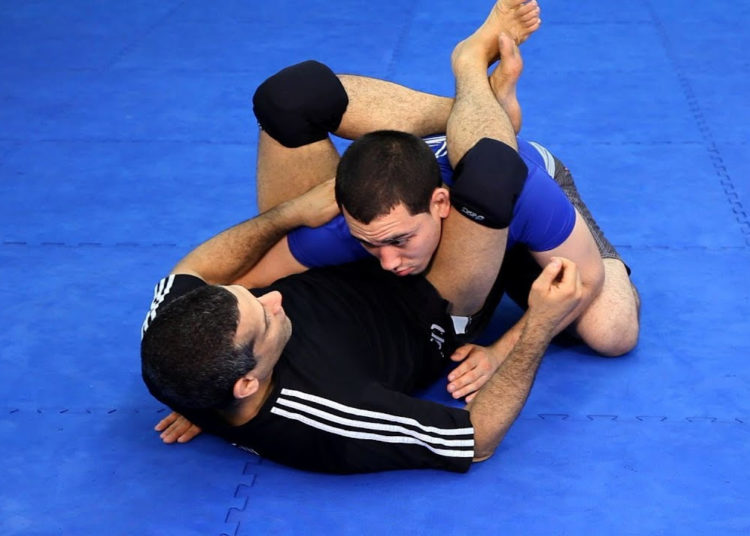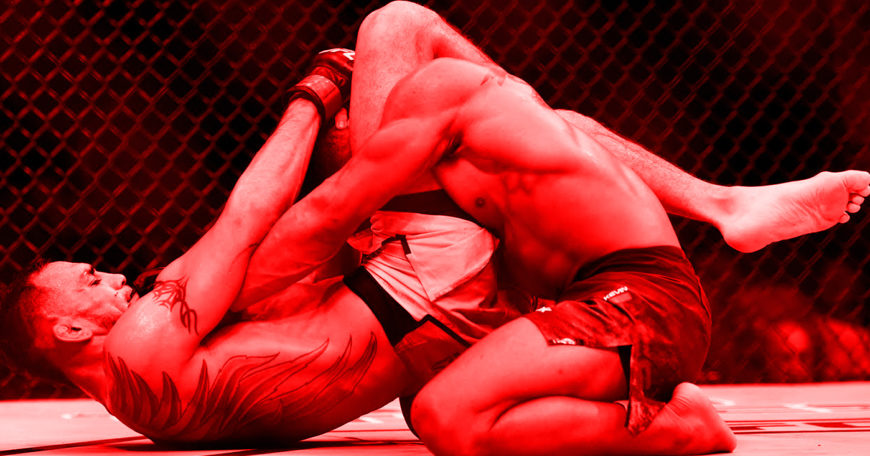The triangle choke is one of the most common and effective fundamental submissions in Brazilian jiu-jitsu and MMA. Many students learn it within the first few weeks of starting BJJ, and both beginners and elite athletes alike often use the triangle to submit their opponents from a variety of positions.
Whether you’ve never seen a triangle choke before or you just want to learn how to make yours more effective after years of practice, here’s a breakdown of this popular submission:
What is a triangle choke?
In its most basic form, the triangle choke is set up by trapping your opponent’s head and one of their arms between a triangle-shaped opening between your legs.
The leg that’s on the opposite side of your opponent’s trapped arm is draped across the back of their neck, the shin tucked under the crux of your other leg.

The submission almost always requires the opponent’s trapped arm to be extended across the centerline of your body. This is because the power of a triangle choke comes from blocking off the blood flow in the carotid artery, making it a blood choke rather than an air choke. In other words, if you don’t tap to a triangle choke, you’ll probably end up taking a nap on the mats. By extending the arm across the body, you essentially choke the victim with their own arm.
Read also: The Best Fundamental Leg Lock Positions In BJJ
How to transition to a triangle choke
Part of what makes the triangle choke so dangerous is that you can enter it from a top or bottom position. The key, though, is that your opponent must have one arm between your legs and one arm outside your legs for it to work.
If they have both arms in, they’ll be able to create the space they need to prevent the choke from ever happening, and if they have both arms out, you’ll (usually) have a tough time finishing the choke from the triangle position unless you have ridiculously thick and strong thighs.
With this concept in mind, here are a few common ways to transition to the triangle choke:
From closed guard:
Secure a grip on each of your opponent’s wrists. In one swift motion, shove one of their wrists back through your legs while pulling the other one across your body. Opening your guard, use your foot to push against their hip and angle yourself in line with their trapped arm — if they were to point with their finger, they should be pointing at your head.
From spider guard:
Ensure your spider guard is established and secure before transitioning to a triangle choke from here. Once you’ve fully established your grips, lift your hips and slip your extended leg from your opponent’s elbow to the back of their neck. Your retracted leg should then slip behind your opponent’s corresponding arm to lock up the choke.
From mount:
Though a triangle choke is a bit harder to set up from mount, it is possible. Control their arms the same way you would in closed guard, pushing one beneath your legs and pulling the other across the centerline of their body. You may have to do some extra work here in pulling their head up so you can slip your leg behind their neck, but that’s usually the hardest part.
Then, lean diagonally across them, using your far-side grip to keep their arm pulled across their body while you post on the mat with your other hand. This can help lift the shoulder of their trapped arm off the mat, creating the space you need to lock up the triangle.
From there, you can try to finish the triangle by leaning forward and increasing the pressure created by their trapped arm, or you can roll over so that your back is once again to the ground, finishing the choke in a guard position.
Finishing the triangle choke
As with any choke, the key to finishing the triangle is eliminating space. Many beginner students learn that the best way to get the tap with a triangle choke is by simultaneously lifting their hips and pulling down on their opponent’s head, and while this isn’t the worst way to finish a triangle choke, it’s also not the best.
Cutting an angle in the direction your opponent’s trapped arm is “pointing” and pinching your knees together can eliminate a lot of space you may not have known was keeping your opponent out of immediate danger.
Underhooking the near-side leg can help you maintain that sharp angle while also controlling an important limb your opponent may try to use to escape the choke. Finally, flex your toes upward so that your feet maintain a firm “boot” position rather than letting your feet stay limp.
This tightens your triangle a surprising amount without requiring the same exertion as trying to squeeze the life out of your opponent with your thighs.
Pulling the head down can assist in the triangle choke finish, but it’s a lot of work, and your opponent’s stubbornness may outlast your arms’ strength, enabling them to escape. Thankfully, you likely won’t even need to resort to this tactic if you refine all the other finishing details first.

Common triangle choke mistakes
Don’t get discouraged if your triangle chokes aren’t perfect right away. If you’re having trouble finishing them, it may be because:
- You’re lying straight back. Again, you’ll get more of a squeeze with your triangles if you cut an angle with your torso. It’s a little extra work, but it’s worth it!
- Your triangle isn’t fully closed. If your knee isn’t locked over your shin, your triangle will likely be too loose. No matter how strong your legs are, crossing your legs calf-to-shin likely won’t be enough to finish the choke.
- They’ve managed to work their other hand or arm in. Remember: a triangle almost always only works if one arm is in and the other is out. If your opponent manages to even get their other hand into the triangle space, it could create the tiny gap they need to buy them time and avoid tapping out.
Triangles can be tough, but don’t give up on them just because they’re a challenge!
A Submission That’s Worth a “Tri”
Whether triangles are your go-to submission or a choke that you only attempt once in a while, you might surprise yourself with just how effective you can make them if you focus on the details.
This fundamental submission is as fun as it is effective, and if you drill it enough, whether your legs are short or long, you can soon have your opponents tapping out as you choke them with their own arm.









